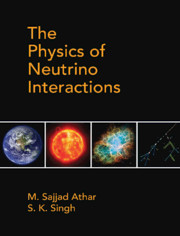Book contents
- Frontmatter
- Dedication
- Contents
- List of Figures
- List of Tables
- Preface
- Acknowledgments
- Chapter 1 Neutrino Properties and Its Interactions
- Chapter 2 Relativistic Particles and Neutrinos
- Chapter 3 Quantization of Free Particle Fields
- Chapter 4 Interacting Fields and Relativistic Perturbation Theory
- Chapter 5 Phenomenological Theory I: Nuclear β-decays and Weak Interaction of Leptons
- Chapter 6 Phenomenological Theory II: Weak Decays of Hadrons
- Chapter 7 Gauge Field Theories and Fundamental Interactions
- Chapter 8 Unified Theory of Electroweak Interactions
- Chapter 9 Neutrino and Electron Scattering from Point Particles
- Chapter 10 Neutrino scattering Cross Sections from Hadrons: Quasielastic Scattering
- Chapter 11 Neutrino Scattering from Hadrons: Inelastic Scattering (I)
- Chapter 12 Neutrino Scattering from Hadrons: Inelastic Scattering (II)
- Chapter 13 Neutrino Scattering from Hadrons: Deep Inelastic Scattering
- Chapter 14 Weak Quasielastic v(⊽)-nucleus Scattering
- Chapter 15 Inelastic Scattering of (Anti)neutrinos from Nuclei
- Chapter 16 Deep Inelastic Scattering of (Anti)neutrinos from Nuclei
- Chapter 17 Neutrino Sources and Detection of Neutrinos
- Chapter 18 Neutrino Mixing and Oscillations
- Chapter 19 Neutrino Astrophysics and the Synthesis of Elements
- Chapter 20 Neutrino Interactions Beyond the Standard Model
- Appendices
- Appendix A Lorentz Transformation and Covariance of the Dirac Equation
- Appendix B Cabibbo Theory
- Appendix C Some Properties of Pauli and Dirac Matrices and Spin Density Matrices
- Appendix D Leptonic and Hadronic Tensors
- Appendix E General Expression for the Total Scattering Cross Section and Decay Rates
- Appendix F Expressions of N(q2), the Coefficients of the Polarization Observables
- References
- Index
Chapter 13 - Neutrino Scattering from Hadrons: Deep Inelastic Scattering
Published online by Cambridge University Press: 22 May 2020
- Frontmatter
- Dedication
- Contents
- List of Figures
- List of Tables
- Preface
- Acknowledgments
- Chapter 1 Neutrino Properties and Its Interactions
- Chapter 2 Relativistic Particles and Neutrinos
- Chapter 3 Quantization of Free Particle Fields
- Chapter 4 Interacting Fields and Relativistic Perturbation Theory
- Chapter 5 Phenomenological Theory I: Nuclear β-decays and Weak Interaction of Leptons
- Chapter 6 Phenomenological Theory II: Weak Decays of Hadrons
- Chapter 7 Gauge Field Theories and Fundamental Interactions
- Chapter 8 Unified Theory of Electroweak Interactions
- Chapter 9 Neutrino and Electron Scattering from Point Particles
- Chapter 10 Neutrino scattering Cross Sections from Hadrons: Quasielastic Scattering
- Chapter 11 Neutrino Scattering from Hadrons: Inelastic Scattering (I)
- Chapter 12 Neutrino Scattering from Hadrons: Inelastic Scattering (II)
- Chapter 13 Neutrino Scattering from Hadrons: Deep Inelastic Scattering
- Chapter 14 Weak Quasielastic v(⊽)-nucleus Scattering
- Chapter 15 Inelastic Scattering of (Anti)neutrinos from Nuclei
- Chapter 16 Deep Inelastic Scattering of (Anti)neutrinos from Nuclei
- Chapter 17 Neutrino Sources and Detection of Neutrinos
- Chapter 18 Neutrino Mixing and Oscillations
- Chapter 19 Neutrino Astrophysics and the Synthesis of Elements
- Chapter 20 Neutrino Interactions Beyond the Standard Model
- Appendices
- Appendix A Lorentz Transformation and Covariance of the Dirac Equation
- Appendix B Cabibbo Theory
- Appendix C Some Properties of Pauli and Dirac Matrices and Spin Density Matrices
- Appendix D Leptonic and Hadronic Tensors
- Appendix E General Expression for the Total Scattering Cross Section and Decay Rates
- Appendix F Expressions of N(q2), the Coefficients of the Polarization Observables
- References
- Index
Summary
Introduction
In 1951, Lyman, Hanson, and Scott [541] were the first to observe elasticelectron scattering from different nuclei using a 15.7 MeV beam obtainedwith the help of the betatron accelerator facility at Illinois. Furtherextensive studies using electron beams started with the development of theMark III linear accelerator (LINAC) in 1953 at the High Energy PhysicsLaboratory (HEPL), Stanford. Hofstadter, Fechter, and McIntyre studied theeffect of electron scattering (Ee ~ 125− 150 MeV) on various nuclear targets andconcluded that these nuclei have finite charge distribution. With increasedenergy (550 MeV) available for scattering, the first evidence of elasticscattering from the proton was observed by Chambers and Hofstadter at HEPLin 1956 [542], using a polyethylene target. Assuming that proton had anexponential density distribution, they found the r.m.s. (root mean squared)radius of the proton to be about 0.8 fm. Later, Yearian and Hofstadterperformed electron scattering experiments on deuteron targets and determinedthe magnetic moment of the neutron [543]. At that time, the investigation ofthe structure of the proton and neutron was a major objective of HEPL, whichwas upgraded to achieve electron beams of energies up to 20 GeV; today, HEPLis known as the Stanford Linear Accelerator Center (SLAC) [544]. By the1960s, it became possible to perform both elastic and inelastic scatteringexperiments at high energies and for a wide range of four-momentum transfersquared (Q2). Thus, by the end of the 1960s,nuclear physics entered the ‘deep inelastic scattering’ (DIS)era, when experiments with 20–40 times higher energies were beingperformed at SLAC; it became possible to probe the hadron. DIS is thescattering of charged leptons/neutrinos from hadrons in the kinematic regionof very high Q2 and energy transferν. During the late 1960s, experiments byMIT-SLAC collaboration, led by Taylor, Kendall, and Friedman [544] confirmedthe scaling phenomenon in the deep inelastic region, which was theoreticallypredicted by Bjorken [545, 546]. They received the 1990 Nobel Prize inPhysics for the experiments. These experimental results confirmed that, inthe scaling region, the constituents of protons behave like free particlescalled partons. Charged partons are identified as quarks and neutral partonsare identified as gluons. Later, many experiments using electron and muonbeams were performed at CERN, DESY, Fermilab, etc.
- Type
- Chapter
- Information
- The Physics of Neutrino Interactions , pp. 507 - 560Publisher: Cambridge University PressPrint publication year: 2020



